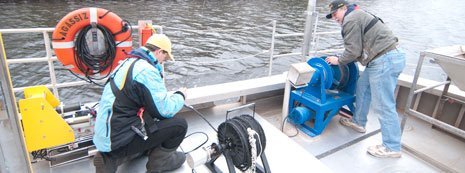Document Type
Article
Publication Date
5-4-2019
Abstract
The emerging shift in Great Lakes management from offshore to nearshore waters will require attention to complexities of coastal hydrodynamics and biogeochemical transformations. Emphasizing hydrodynamics, this work resolves transport processes in quantifying discharge plume and pollutant of concern (POC) footprint dimensions, the latter being the portion of the plume where water quality standards are not met. A generic approach, isolated from pollutant-specific biokinetics, provides first-approximation estimates of the footprint area. A high-resolution, linked hydrodynamic-tracer model is applied at a site in the Greater Toronto Area on Lake Ontario. Model results agree with observed meteorological and hydrodynamic conditions and satisfactorily simulate plume dimensions. Footprints are examined in the context of guidelines for regulatory mixing zone size and attendant loss of beneficial use. We demonstrate that the ratio of the water quality standard to the POC concentration at discharge is a key determinant of footprint dimensions. Footprint size for traditional pollutants (ammonia, total phosphorus) meets regulatory guidelines; however, that for soluble reactive phosphorus, a presently unattended pollutant, is ~1–2 orders of magnitude larger. This suggests that it may be necessary to upgrade treatment technologies to maintain consistency with regulatory guidelines and mitigate manifestations of the eutrophication-related soluble reactive phosphorus POC.
Publication Title
Journal of Marine Science and Engineering
Creative Commons License

This work is licensed under a Creative Commons Attribution 4.0 International License.
Recommended Citation
Huang, C.,
Kuczynski, A.,
Auer, M. T.,
O'Donnell, D. M.,
&
Xue, P.
(2019).
Management transition to the Great Lakes nearshore: Insights from hydrodynamic modeling.
Journal of Marine Science and Engineering,
7(5).
http://doi.org/10.3390/jmse7050129
Retrieved from: https://digitalcommons.mtu.edu/cee-fp/104
Version
Publisher's PDF


Publisher's Statement
©2019 by the authors. Licensee MDPI, Basel, Switzerland. Article deposited here in compliance with publisher's policies. Publisher's version of record: https://doi.org/10.3390/jmse7050129